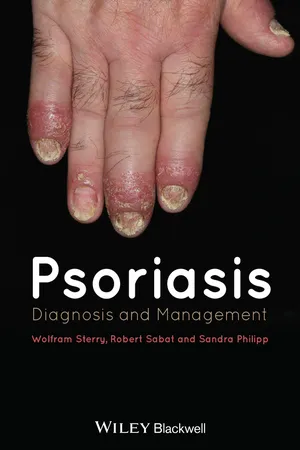
Psoriasis
Diagnosis and Management
- English
- ePUB (mobile friendly)
- Available on iOS & Android
Psoriasis
Diagnosis and Management
About This Book
Practical and user-friendly, this is the ideal guide to the diagnosis and treatment of psoriasis, helping you navigate a logical management pathway through a complex maze of possibilities. Psoriasis is a cruel disease that can seriously affect the sufferer's quality and length of life. It is also highly idiosyncratic, with features that vary greatly from patient to patient; this being mirrored in the highly variable response to treatment. It is increasingly recognized that psoriasis is not a discrete disease and that many patients suffer two or three comorbid conditions that can complicate the efforts of doctors treating patients. Psoriasis: Diagnosis and Management will provide dermatologists of all levels with a practical, well-illustrated approach to fully understanding the disease, including clear, clinical guidance to enable best-practice and effective management of patients. In full color throughout and excellently illustrated, key highlights include:
- easily understandable description of the psoriasis pathogenesis;
- a strong emphasis on the clinical features of psoriasis;
- careful consideration of comorbid conditions as part of the psoriatic spectrum to be managed;
- coverage of both traditional and contemporary management approaches;
- plenty of diagnostic algorithms and management protocols to aid the daily practical care of patients.
Brought to you by several of the world's leading authorities on the subject, Psoriasis: Diagnosis and Management is an essential purchase for the dermatologist.
Frequently asked questions
Information
Part I
Epidemiology and economic aspects
Chapter 1
Epidemiology and economic aspects
Epidemiology
Descriptive epidemiology
Incidence—there are few studies
Prevalence
| Country | Ascertainment method | No. of subjects (age) | Measurea | Estimate ×100 |
| Faroe Islands | Clinical examination | 10,984 | PT | 2.8 |
| Norway | Questionnaire | 14,667 (20–54 years) | LT | 4.8 |
| Norway | Questionnaire | 10,576 | PT | 1.4 |
| Sweden | Monitoring of diagnoses | 159,200 | PP | 2.3 |
| Denmark | Questionnnaire | 3892 (16–99 years) | LT | 4.2 |
| Croatia | Clinical examination | 8416 | PT | 1.5 |
| USA | Clinical examination | 20,749 (1–74 years) | PT | 0.8–1.4b |
| China | Monitoring of diagnoses | 670,000 | PT | 0.05–0.84 |
| England | Questionnaire and clinical examination | 2180 | PT | 0.6–1.6b |
| Australia | Questionnaire and clinical examination | 1037 (adults) | PT | 2.3 |
| Italy | Questionnaire | 3660 (>44 years) | LT | 3.1 |
| Germany, working adults | Examination | 90,880 | PP | 2.0 |
| USA | Questionnaire | 10,122 | LT | 3.1 |
| Sweden, male conscripts | Examination | 1,226,193 (20 years) | LT | 0.5 |
| United Kingdom UKGPRD | Examination | 7,533,475 | PP | 1.5 |
| USA (Caucasians vs African Americans) | Questionnaire | 21,921 vs 2443 | LP | 2.5 vs 1.3 |
| Spain | Questionnaire | 12,938 | LP | 1.17–1.43 |
| Portugal | Questionnaire and clinical examination | 1000 | PP | 1.9 |
Ethnic and geographic variations
Table of contents
- Cover
- Title page
- Copyright page
- List of contributors
- Preface
- Part I: Epidemiology and economic aspects
- Part II: Etiology and pathogenesis
- Part III: Clinical features/diagnostic procedure
- Part IV: Evaluation of disease severity
- Part V: Psoriasis and associated diseases
- Part VI: Therapeutic management
- Index
- End User License Agreement